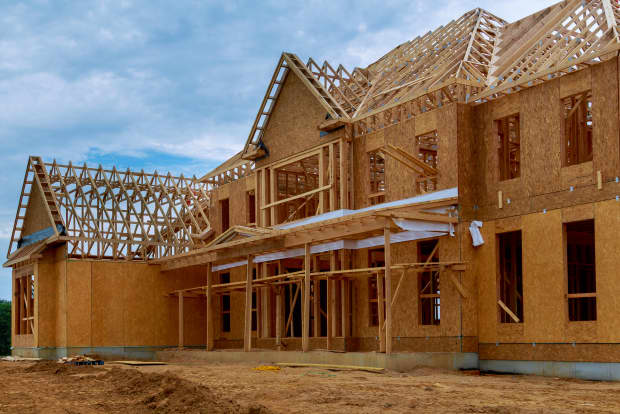This post was originally published on this site

New homes could get more expensive because of a pandemic-related spike in lumber prices.
Getty Images/iStockphoto
Lumber’s gotten way more expensive — and harder to find — which could create headaches for home buyers.
Initially when the coronavirus pandemic began, lumber prices slumped. Construction activity had ground to a halt, leaving mills with excess supply of wood. But in recent months, building activity has resumed with a bang.
And mills weren’t prepared. With inventories low and demand so high, lumber prices increased some 60% over the past six months, compensating for the loss at the start of the year.
Adding to the constraints caused by the pandemic, the impact of tariffs on wood from Canadian mills continues to cause elevated prices for American construction firms.
That sudden rise in prices could have major implications for the home-building industry.
“Framing lumber makes up roughly a fifth of the materials cost of building a home,” said David Logan, director of tax and trade analysis at the National Association of Home Builders. “When we see a price increase this large over such a short period, it’s going to have negative effects on affordability for prospective home buyers.”
Builders will pass on the higher cost of lumber to buyers in the form of higher prices for newly-built homes. But it isn’t just new buyers that could see higher costs as a result of the current situation. Americans already under contract for a new home could feel some of the pain as well.
“The first choice of any buyer and builder is to try to work to keep the existing contract viable,” Logan said. “But there comes a point at which builders can no longer absorb those costs and they necessarily have to be passed onto the buyer.”
Don’t miss: Black homeownership has declined since 2012 — here’s where Black households are most likely to be homeowners
Cash-strapped builders may look to renegotiate contracts with buyers. In these cases, buyers have multiple options to reduce the cost of the home if it’s suddenly outside their budget. They can revisit finishes like upgraded countertops or flooring, or they could reduce the structure’s size.
The last time lumber prices increased this much, back in 2018, the square footage of newly-built homes dropped, Logan said.
The situation with lumber prices, though, could have long-term implications that may affect all home buyers across the country. Before the pandemic started, the U.S. had a major housing shortage.
“ ‘When we see a price increase this large over such a short period, it’s going to have negative effects on affordability for prospective home buyers.’ ”
Over the past decade, because of increased costs and the after-effects of the housing crisis, builders mostly focused on constructing homes at the top end of the market. More recently, that was starting to shift.
“Builders indicated that this year they were going to start showing a lot more supply in the mid range of the market,” said George Ratiu, senior economist at Realtor.com. “They had basically tapped out the top end.”
(Realtor.com is operated by News Corp NWSA, +1.77% subsidiary Move Inc., and MarketWatch is a unit of Dow Jones, which is also a subsidiary of News Corp.)
Read more: Mortgage rates keep falling to record lows — so is now a good time to refinance?
The entry-level and mid-range of the market is where most of the demand is. The trouble for builders, though, is that building lower-priced homes inherently means tighter margins and less room for error. Rising lumber prices threaten those margins and make building more affordable homes less financially appealing.
Ultimately, builders’ choice of what types of homes to construct could come down to whether or not Americans want to continue living in denser, more expensive urban areas.
“The move to the suburbs is likely to offer them slightly lower land acquisition costs,” Ratiu said. “This is where new home construction has a real opportunity to shine.”


